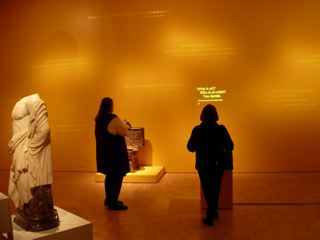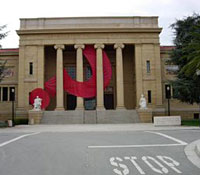Do Visitors Question
In 2004, the Cantor Arts Center at Stanford University presented Question, an experimental exhibition and set of programs designed to challenge assumptions about art and its presentation in museums. It was intended to raise complex issues and present opportunities for the museum to experiment with the exhibition process, to engage in cross-disciplinary collaborations among staff and with outside consultants, to present its permanent collection in new ways, and to investigate how visitors learn in its galleries.
Tom Seligman, the museum’s executive director, was in the midst of a yearlong endeavor to turn the museum’s traditional exhibition development process inside out. On this project, he expected staff to:
- throw out their assumptions about the presentation and interpretation of art, in order to challenge themselves and engage visitors in new ways;
- distill a list of queries from the general public and university student visitors, and use them to create the exhibition;
- work in interdisciplinary teams—something they had not really done before.
I was hired to work with the Cantor staff to develop a new framework for collaboration to transform the Question concept into a visitor experience. I was asked to help staff focus ideas, consider new ways of presenting art, and design an installation that was true to the learning goals established for the project. I brought installation artist and interactive designer Michael Brown onto the project, and together with museum staff we attempted to transform the entire museum—inside and out—into a Questionrelated experience, and to bring new ideas for interactivity and visitor participation into the museum.
Because there was an expectation that the Question exhibition should be different than the other museum galleries or anything the Cantor Arts Center had ever done before, the process was difficult and, at times, contentious. Staff members were polarized. They disagreed about the intended audience, the nature of learning in museums, and whether an exhibition should emphasize objects or ideas. After an arduous and lengthy meeting, we finally agreed on what we would like visitors to think and feel after experiencing the exhibition:
- I am part of this place.
- My response to art is valid.
- I have learned new ways to appreciate art.
The Questions
Based on visitor surveys conducted before I joined the team, staff synthesized visitor responses into 20 questions that shaped the development of the exhibition:
- What constitutes an original?
- Is there such a thing as bad art?
- This looks like something a child could do. Why is it in an art museum?
- What is artistic quality?
- Why are these worn, broken, or imperfect objects in the museum’s collection?
- Are sacred objects changed when shown in a museum setting?
- Can people understand art from cultures or periods other than their own?
- Is it art or is it craft?
- Who decides what is art and who is an artist?
- Why should I want to look at something that is disturbing?
- Have I looked at this piece long enough? Why should I give myself more time to look at it?
- Are ideas more important than physical objects?
- Where is the meaning in the work?
- What constitutes authenticity in a work of art?
- Why are these objects grouped in this way?
- Does the way we care for objects affect our understanding of them?
- How is the value of a work of art determined?
- Are these works shown as they were meant to be seen?
- How does art provoke an emotional response?
- What color should we paint this wall and why?
Some of the most basic questions, such as “What is artistic quality?,” “Where is the meaning in the work?,” and “Who decides what is art, and who is an artist?” were the most provocative for the staff and stimulated animated discussions.
Once the questions were identified, curators and other staff selected objects from the Cantor Arts Center’s comprehensive collection of 26,000 works to illustrate the specific questions. We spent a lot of time listening to the curators’ intentions and arguments, and agreed to try to create a design in which the presentation of the objects revealed the questions. For example, we created an interactive exhibit in which visitors could change the wall color surrounding a large framed painting. We chose not to state the question, “What color should we paint this wall and why?” Instead, we encouraged visitors to choose a color paint chip and insert it into a slot that projected the color onto the wall around the painting. By doing so, visitors could see that the color dramatically changed the appearance of the painting. Ultimately, each of the questions was given a space in the exhibition, with exhibits and artworks designed to actively engage visitors in exploration of the question.
Because of the visitor focus of the exhibition and an emphasis on the act of questioning, we incorporated a diversity of visitor-response elements into the design, including walls to write on, comment books, a wall of magnetic words on which visitors could construct their own phrases and expressions, sketch books, and a space where visitors could add their own definitions to a wall of quotes about art.
Summative evaluation conducted by the museum’s education staff, Johanna Jones of Randi Korn & Associates, and Stanford graduate student Susie Wise revealed that frequent art museum visitors were challenged and provoked in the installation, while visitors who were unaccustomed to visiting art museums were confused and wanted more information. Tracking and timing studies showing that visitors spent most time at the interactive and visitor response exhibits—evidence that staff should provide more opportunities for visitors to engage interactively in exhibitions about art.
In the end, we created an installation that provided numerous ways for visitors to interact with the artworks, explore their own ideas about art and museums, and contribute their ideas and questions to the exhibition dialogue. And the exhibition raised even more questions than it answered, for staff as well as visitors.

Signs advertising Question appeared all around campus, signaling an unusual event. Designed to look like campaign signs, they included a space for people to write graffiti and messages. A few people actually wrote on them with messages like “Where’s the art museum?” But they were not used very often, probably because “permission” was unclear.
An entry tunnel deposited visitors into the middle of the galley, creating some disorientation and forcing them to choose which way to go. Printed on a large white wall were the words “What are your questions about art?” Tethered pencils afforded the opportunity for visitors to respond. Some people drew graffiti, and many more people responded with comments like “What were abstract expressionists thinking?,” “How can I get a job here?,” “How many artists does it take to change a light bulb?,” and “I have to think about it but thank you for letting me write on the wall.”

The wall also contained small window-like holes that framed art objects in the gallery beyond. Some people responded to the framed views: “I would never have noticed that.”
A visitor comment book asked the question, “Where is the meaning in a work of art?”
In a separate room there were prints on two of the walls and the other two walls were sheathed in metal. Reproductions of each work and evocative oversized magnetic words encouraged visitors to create phrases and poetry that revealed their emotional responses to the artworks.

In this comment book focused on art that is disturbing, visitor comments ranged from anger to the value of freedom of speech. The “f.u.” refers to a phrase used in one of the artworks in that section.
One large wall in the exhibition contained famous quotes that defined art and described artists. Visitors could add their points of view to the wall by typing into a computer that projected their thoughts among the other quotes. Above the computer keyboard were the words “What is art? Who is an artist? You decide.” The last 10 entries continued cycling on the wall when no one was making an entry.
Darcie Fohrman is a member of the Museum Group. She consults with museums of all types to create multidisciplinary, interactive exhibitions.
